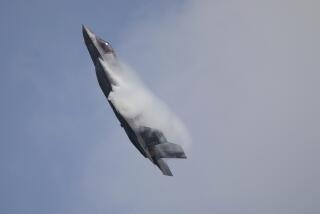Accused Officer Gives Account of Shoot Down : Military: Capt. Jim Wang, charged in downing of two U.S helicopters over Iraq, says he would have stopped mission. Twenty-six died.
- Share via
OKLAHOMA CITY — An Air Force captain charged in the downing of two U.S. helicopters over northern Iraq testified Friday that he didn’t see green dots on his radar screen that would have helped identify the choppers.
Capt. Jim Wang was senior director aboard an Airborne Warning and Control System radar plane monitoring the “no-fly” zone on April 14, 1994, when F-15 fighter planes shot down two Army helicopters, killing 26 people.
Wang testified at his court-martial that if he had had any indication the jets were streaking toward something other than enemy aircraft, he would have called them off.
The 29-year-old Wang is accused of failing to actively supervise two officers, not keeping an accurate tactical picture of the area and not letting the F-15 pilots know friendly helicopters were in the area.
He could be discharged from the Air Force and get up to nine months in prison.
The defense rested its case following Wang’s 5 1/2 hours on the stand. Closing arguments are expected Monday.
Much of the testimony centered on whether Wang saw green or brown dots on his radar scope before the shoot down, and how what he saw compared with two taped replays of the mission.
*
Brown dots appear wherever radar detects an aircraft. The AWACS planes also can pick up electronic signals, called IFF, that identify whether an aircraft is friend or foe. Those signals show up green, and also contain information that allows a radar operator to tell whether the aircraft is friendly.
Wang said he saw only brown dots in the area where the F-15 fighters reported making contact with an unknown aircraft, and that he took some steps to try to identify them.
A computer-generated replay of Wang’s scope during the mission shows a green dot in the area of engagement, and a videotape taken from an empty console appears to show the same.
The defense has questioned the validity of both, contending they fail to reflect what Wang’s scope showed.
“What would you have done if you had seen a continuous green IFF return?” defense attorney Frank J. Spinner asked.
“If I knew that was what the F-15s were going after, I would have stopped the engagement,” Wang said.
Wang said the F-15s were better equipped to identify the unknown aircraft electronically, and noted that the pilots made a visual identification before firing.
The lead fighter pilot, Capt. Eric Wickson, has admitted that he visually misidentified the UH-60 Blackhawks as Iraqi Hinds.
More to Read
Sign up for Essential California
The most important California stories and recommendations in your inbox every morning.
You may occasionally receive promotional content from the Los Angeles Times.










